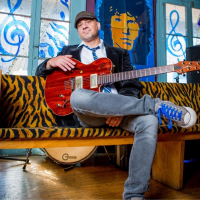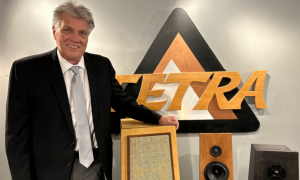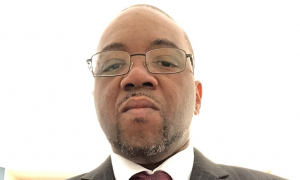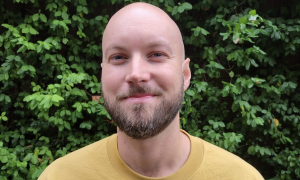Home » Jazz Articles » Chats with Cats » The Instrument Maker: Roger Sadowsky
The Instrument Maker: Roger Sadowsky

Courtesy Larry DiMarzio
It's about good wood, good workmanship, good materials ... and the best craftsmanship we can possibly put into these instruments.
—Roger Sadowsky
About Roger Sadowsky
Roger Sadowsky is one of the most highly respected instrument makers in the world. Based out of New York City, he gained early acclaim for outstanding repair and restoration work on guitars and basses.In the early 1980s, the heated vintage market increasingly pushed guitars and basses out of reach of working musicians. In response, Roger realized that it made sense to build instruments from scratch that incorporated all of the improvements that he had developed over the years. Additionally, his background in acoustic guitar building helped him to build lightweight, acoustically resonant instruments.
Today, Roger leads an experienced team that is dedicated to improving building techniques and finding innovative materials to build the best instruments for his customers.
All About Jazz: Could you tell me how you became a guitar maker?
Roger Sadowsky: I started making guitars in 1972, making flat top acoustic guitars and I got into it because I went to college at one of the state colleges in upstate Western New York. During my junior year, this would have been in 1969, they held a folk festival and I went to it. There were a bunch of professional folk musicians, and there were a lot of people with quilts, long hair, and macrame, and I just felt at home. So, that started my progression to playing guitar and becoming a folky single picker.
Then I went on to graduate school where I was working on a PhD in psychobiology but I was miserable. I pretty much got obsessed with the guitar. I wrote letters to guitar makers all over the world and no one would take me on as an apprentice. So I quit graduate school in 1972 and took a job at a music store selling guitars. They were selling these acoustics by this guy named Augie Loprinzi in New Jersey. So I went down to see Augie, he gave me a job, and that's how it all started. I've been doing it ever since.
AAJ: Who was your inspiration for instrument making and what makes them great?
RS: Initially I was inspired by vintage Martin guitars. The level of craftsmanship and the level of workmanship on those were fantastic. In '74 I took over running the repair department at a music store outside of Philadelphia. Honestly, in the '70s, the quality of U.S. guitar manufacturing had fallen to an all-time low so it gave guys like me, who got into it in those years, the opportunity to get a foot in the door because a lot of what I was doing was upgrading the quality of those instruments.
I remember people buying brand new guitars in the '70s and immediately bringing them to me to re-true the fingerboard and refret them so that they would play well. I also mastered electronics work, fielding, and noise reduction, and so much of my work was just taking what was out there and making them better. As far as other guitar makers who were my inspiration, I didn't have a lot of those at that time. There weren't that many outside of the major manufacturers. There were a few smaller acoustic makers but there weren't many smaller electric guitar makers. I think Alembic was just getting off the ground in San Francisco. I think I only saw one Alembic during the entire 1970s. So, it was really about upgrading and customizing instruments.
Almost all of my clients in those early days were the working session guys in Manhattan. They were doing all the jingles, all the record dates, all the corporate dates and all of that stuff. A lot of them had nice instruments from the sixties like the Fenders and the Gibsons. In those days you could go out and buy, let's say a '60s Fender J-Bass (Jazz Bass), which were fabulous instruments, for eight hundred bucks. Then they would bring it to me, I would re-true the fingerboard, refret it, shield the electronics, replace some of the hardware, and install my preamp circuits that I was pioneering in the '80s. So, for fifteen hundred bucks they ended up with a really first-rate, functioning, professional-quality instrument. But then in the mid-'80s the vintage market took off. All of a sudden that eight hundred dollar, early '60s Fender bass, was now fifteen hundred dollars and I realized that anything I would be doing to upgrade that instrument would be devaluing it as a vintage instrument. That's when I decided I needed to start taking all of the improvements that I was bringing to the table, via modification work, and make my own instruments. So, I started building my electric guitars in 1980 and basses in 1982, but I really started building a lot more in the later '80s and definitely in the '90s.
AAJ: I've often heard about the "Sadowski Sound." Could you describe that to me?
RS: That all goes hand in hand with my adoption of active tone circuits. Guitar players never had much interest in that, it didn't seem to bring much to the table. But for my bassist clients, what it did was enable them to cut through the mix and be able to be heard either in a recorded track or live. The circuit I began using was made by Bartolini. It was a transistor bass circuit and just had a treble boost and a bass boost. When more of this stuff started coming on the market they tended to be based on op-amp designs which enabled them to cut as opposed to just boosting. And the other thing that earlier circuits had was mid control. In a transistor bass circuit you can't cut or boost mids without influencing treble and bass curves. I love the sound of this transistor bass circuit so I never went to three band preamps. But, once I started putting this preamp into basses belonging to people like Will Lee, Marcus Miller, Neil Jason, and all these top studio guys...
I mean, I can remember as early as 1982 when (David) Letterman started we all had Sony Trinitrons with little two inch speakers in them and people would just come into the shop and say, "I can't believe how good your bass sounds on TV." I kept getting that over and over again to the point where I was starting to feel a little embarrassed because what could you hear through those speakers [laughs]?
But the point is that circuit proved to be the magic bullet for my sound. I've never varied from that even though I started making my own circuit in 1990, my circuits always stayed true to that original design of being based on transistors and not op-amps. To this day I get an amazing number of emails from recording engineers and front-of-house sound guys all saying the same thing, that they don't have to touch anything on the board when dealing with one of my basses. It's just plug and play and, to me, that's about the best compliment I think I could get.
AAJ: Since you started building instruments have the kinds of things that musicians are asking for changed at all?
RS: Not so much for me. I'm a bit outside of the mainstream "M.I" (musical instruments) as it's referred to. I don't really pay a lot of attention to what the other guys are doing but I think when you look at what Gibson and Fender have been through in the last ten years with changes of ownership, all these companies are just going back to basics now. They're just trying to make what they made in the '60s, and make them as good as possible. A few years ago Gibson was putting automatic tuning gears on a Les Paul. Nobody wanted that. So, they're all going back to what made their companies great in the beginning and focusing on that
AAJ: You've always been independent although I was reading that you recently teamed up with Warwick. Are you still independent and have you wanted it that way?
RS: What that was all about was, starting back in 2003, I started manufacturing a lot of my instruments in Japan in partnership with my Japanese distributor. That's where the Metroline and the Metro Express began. The instruments were phenomenal and, of course, at a lower price than what I make here in my custom shop. The problem for me was that my partner was only interested in the Japanese market so I had to handle all the sales and distribution outside of Japan. As I'm getting older, I'm seventy-two now, I want to spend less time doing that kind of stuff and more time being back at my work bench.
So I decided to seek out a new partner who, not only had an amazing factory and amazing manufacturing capability, but also had worldwide distribution. And that's what I found in Warwick. They have the most amazing factory I've ever seen of all the factories I've seen in the U.S., Korea, and Japan. Warwick totally blows every one of them away. And, in addition, they're a carbon-neutral factory with worldwide distribution. So it was the first perfect partner for me. Hans-Peter Wilfer of Warwick was thrilled that I approached him about that and so we signed a licensing agreement in 2019 and production began in January of 2020 just as the pandemic began [laughs].
So, they make the Metroline in Germany and make the Metro Express at a factory that they use for their own instruments in China. I'm now just the Sadowsky NYC Custom Shop and am committed under my licensing agreement to make up to fifteen basses a month. And, as a result, I've downsized my crew from eleven pre-Covid down to four. And we're just dealing directly with customer orders and not making instruments for dealers anymore. I'm certainly much happier not managing the larger shop.
I always wanted to deal directly with the players. I never really wanted to get bigger and have a lot of dealers. I had always dealt with dealers who had approached me, I never went out looking for dealers. I stopped all the dealer sales and we're just dealing one-on-one with customers now. I'm the one taking all the orders and dealing with the customers and I get a lot of satisfaction out of that.
AAJ: You have to slow down at some point, right?
RS: Well, I'm not slowing down [laughs]. I'm still working six days a week, eight to ten hours a day. But there's much less stress involved.
AAJ: Maybe it's just about what you want to do then?
RS: Exactly.
AAJ: As you mentioned earlier you've made instruments for some of the greatest musicians. Can you tell me what it's like to see your instrument being played by them?
RS: Of course it's very very gratifying. I have to be totally honest with you and say that I've never been a starfucker. I've never sought out celebrity clientele. It's always been gratifying when they come to me but I get just as much satisfaction from a guy doing a weekend bar band gig who sends me an email saying how he is now going to sell all of his other basses because mine blows them all away. That gives me as much satisfaction as anything else. Yea, it's very nice. It's very satisfying. It's great for my brand to have some very well-known players playing my stuff but that's not what it's about for me.
AAJ: Do you foresee any changes in the way instruments are made?
RS: Not really. My attitude is that we're always making micro improvements in our pickups or our hardware or whatever. But, to me, it's just about continuing what I'm doing. I don't feel there are a whole lot of innovations to be made and the most of the ones that are made aren't that earth shaking and don't last long [laughs]. So for me, as it has been for fifty years, my approach is that solid body instruments are still, first and foremost, acoustic guitars. The wood has a tremendous effect on the tone of the instrument. So it's about good wood, good workmanship, good materials whether it's the pots or the tuning machines, and the best craftsmanship we can possibly put into these instruments. I personally check and set up every instrument before they leave the shop and I'm not looking for anything beyond that. We do what we do, we do it well, and I don't see any major changes.
AAJ: What you do requires a lot of technical knowledge about wood, about acoustics, about electronics, etc. How did you acquire all of that knowledge?
RS: I acquired it by osmosis. Back when I started there were, maybe, one or two books in the world on guitar making. Again I got my basics working for Loprinzi in terms of wood, and tooling, and making jigs and fixtures and all that kind of stuff. The five years I spent at Medley Music in Philly gave me access to thousands of instruments for me to learn on, so to speak. By that time some new books started coming out which certainly had a beneficial influence on me.
The other thing is that I always surrounded myself with players who gave me the kind of feedback I needed of what was working or not working for them out in the real world. So a lot of it was them coming to me saying, "I have this problem when I play in the pit" or, "I'm getting this interference," or whatever, and just figuring it out. I mean I'm a smart guy and I use all the resources available to me to troubleshoot these issues. I was also lucky that I had a mentor for electronics who I met in 1977 and, for about five years after, was my Sensei. When I was stumped about how to address something electronically I would reach out to him and he would give me the direction I needed. But for the most part after that I was self-taught.
AAJ: Is there somebody that you still would like to make an instrument for?
RS: Oh, wow. That's a good question. Yeah, I'd like to make instruments for a lot of people but, again, it's not like I seek them out. I'm here and I'm ready when they come to me and I really am happy to make instruments for everyone and anyone who will appreciate what I do and what I have to bring to the table.
AAJ: Fair enough.
Tags
Chats with Cats
B.D. Lenz
United States
New York
New York City
Philadelphia
san francisco
Will Lee
Marcus Miller
Neil Jason
PREVIOUS / NEXT
Support All About Jazz
 All About Jazz has been a pillar of jazz since 1995, championing it as an art form and, more importantly, supporting the musicians who make it. Our enduring commitment has made "AAJ" one of the most culturally important websites of its kind, read by hundreds of thousands of fans, musicians and industry figures every month.
All About Jazz has been a pillar of jazz since 1995, championing it as an art form and, more importantly, supporting the musicians who make it. Our enduring commitment has made "AAJ" one of the most culturally important websites of its kind, read by hundreds of thousands of fans, musicians and industry figures every month.





















